HAPPY BIRTHDAY GEORGE
Was He a Bad Boy?
Washington’s birthday is a proper time to think about cherry trees. Rather than question whether or not George did chop down the tree, and whether or not he had the honesty to admit to the act, I wonder what kind of a cherry it could have been. (The story, incidentally, is apocryphal, having been fabricated by Mason Locke Weems for his 1802 book, Life of George Washington; With Curious Anecdotes, Equally Honorable to Himself and Exemplary to his Young Countrymen. “Parson” Weems also wrote of Washington throwing a silver dollar across the Delaware River).
That cherry tree could very well have been something akin to the sweet cherries we can buy or grow today. 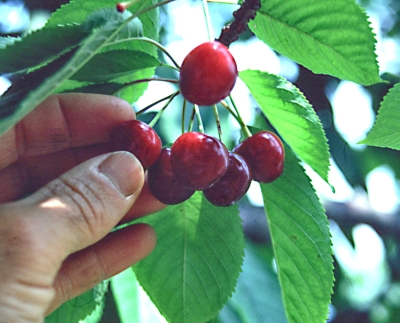 Sweet cherries (Prunus avium), sometimes called bird cherries or, in their more wild state, mazzard cherries, were amongst the plants ordered from Europe by the Massachusetts colony in 1629. By 1650, there was a cherry orchard in Yonkers, New York, and before the end of that century, there were plantings in Rhode Island, Maryland, and Virginia. Trees became so abundant that in 1749, Peter Kalm wrote that “all travellers are allowed to pluck ripe fruit in any garden which they pass by, provided they do not break any branches; and not even the most covetous farmer hindered them from so doing.” So it is not unlikely that Papa Washington had a few sweet cherry trees planted at his farmstead along the shores of the Rappahannock River.
Sweet cherries (Prunus avium), sometimes called bird cherries or, in their more wild state, mazzard cherries, were amongst the plants ordered from Europe by the Massachusetts colony in 1629. By 1650, there was a cherry orchard in Yonkers, New York, and before the end of that century, there were plantings in Rhode Island, Maryland, and Virginia. Trees became so abundant that in 1749, Peter Kalm wrote that “all travellers are allowed to pluck ripe fruit in any garden which they pass by, provided they do not break any branches; and not even the most covetous farmer hindered them from so doing.” So it is not unlikely that Papa Washington had a few sweet cherry trees planted at his farmstead along the shores of the Rappahannock River.
That abundance of cherry trees and cherries is interesting because here in the Hudson Valley, in Eastern US in general, sweet cherries are not an easy crop. The trees’ early blossoms are susceptible to late spring frosts, and the fruits are attacked by such insects as cherry fruit fly and plum curculio, and diseases such as brown rot and black knot. I gave up on sweet cherries. Tart cherries are easier to grow but, of course, aren’t sweet.
And that legendary felled tree could also have been a tart cherry (P. cerasus).

Northstar tart cherry
Though native to the Caucasus Mountains, this tree has been grown in a lot of different places for a long time. The ancient Romans knew eight different varieties, and by the 17th century, 24 different varieties were grown in England. Colonists in Massachusetts planted tart cherries (the variety ‘Red Kentish’), so this tree also may have made its way in the nursery trade south to Virginia a hundred years later.
What Cherry Georgie Probably Did Not Chop Down
One thing is certain: The famous cherry tree could not have been one of the ornamental types commonly planted these days. These ornamental, nonfruiting cherries originated in Asia and were introduced into America after the “opening” of Asia a one hundred and fifty years ago. 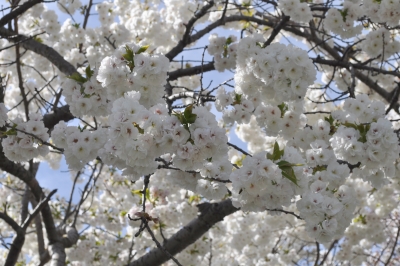 The most famous of these species is perhaps the Yoshino cherry (P. x yedoensis), trees of which fringe the tidal basin in Washington, D.C. Other Asian species also introduced around the turn of the last century include the Higan cherry (P. subhirtella), the Sargent cherry (P. sargentii), and, perhaps the most widely planted today, the Japanese flowering cherry (P. serrulata).
The most famous of these species is perhaps the Yoshino cherry (P. x yedoensis), trees of which fringe the tidal basin in Washington, D.C. Other Asian species also introduced around the turn of the last century include the Higan cherry (P. subhirtella), the Sargent cherry (P. sargentii), and, perhaps the most widely planted today, the Japanese flowering cherry (P. serrulata).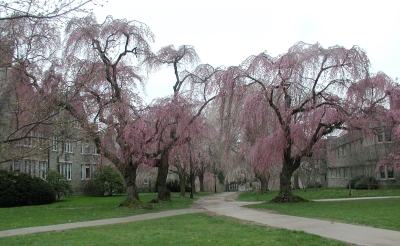
Besides exotic introductions, eastern U.S. abounded in Washington’s time, and still abounds, with wild cherries. Our native pin cherry (P. pennsylvanica, also called bird cherry) is not much more than a bush, so would hardly have a trunk worthy of legend. If George had cut down a chokecherry (P. virginiana), another of our native species, his father probably would not have been riled. The tree doesn’t grow very large, and the fruit, to quote William Ward (1634), “so furre the mouth that the tongue will cleave the roof.” Good wildlife food, though, both these species.
Also abundant — in fact, I am looking at three large, wild trees from my window as I write — is our native black cherry (P. serotina), also known as the rum cherry. This species is sometimes called the American sweet black cherry, but “sweet” stretches reality a bit. Fruits of some trees have respectable flavor, but it’s is accompanied by bitterness. Colonists did eat the fruit or, more often, concoct it with rum from the West Indies to make a cherry liqueur. Hence, the name “rum cherry.”
Black cherry fruit is enjoyed by birds and some humans, and the tree can be attractive, especially (in mid-May here in the Hudson Valley) when the branches will be drooping with long, white chains of flowers. 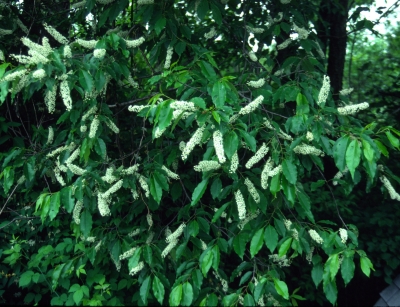 The best part of the black cherry tree is the wood, a hardwood which, with some sanding and then oil or varnish, takes on a soft brown finish, with just a hint of red. Now, just suppose that George Washington had chopped down one of these cherry trees. Could it have been an act of mischief, or could our president-to-be have had some loftier purpose in mind?
The best part of the black cherry tree is the wood, a hardwood which, with some sanding and then oil or varnish, takes on a soft brown finish, with just a hint of red. Now, just suppose that George Washington had chopped down one of these cherry trees. Could it have been an act of mischief, or could our president-to-be have had some loftier purpose in mind?
But I forgot for a moment — the story is apocryphal.


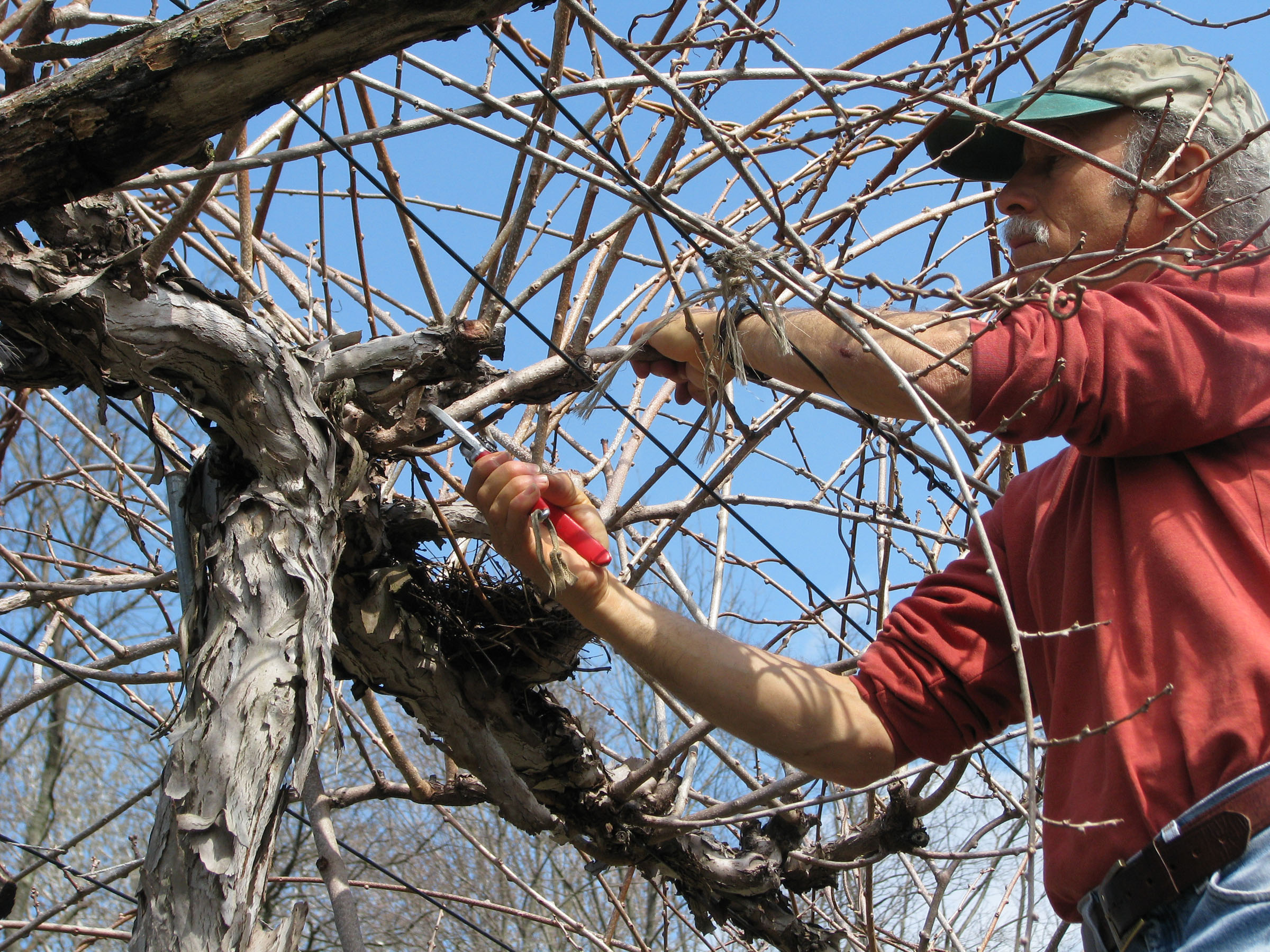
I use the branch bark from P. Serotonin as a cough suppressing ingredient in syrups.” Wild cherry bark” (Decocted)